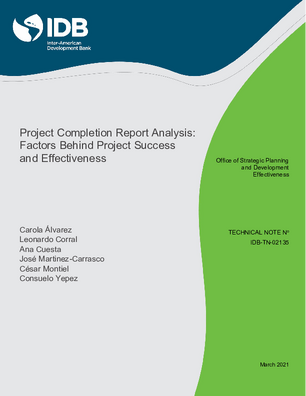Project Completion Report Analysis: Factors Behind Project Success and Effectiveness
Date
Mar 2021
The goal of development assistance is to deliver measurable results. At the Inter-American Development Bank (IDB), the Development Effectiveness Framework (DEF) was adopted to enhance the likelihood this goal is met. The key objective of this analysis is to enhance our understanding of the role the set of tools and processes adopted at the IDB, from project design to completion, play in the assessment of a projects success and effectiveness. Specifically, we are interested in teasing out the role different dimensions of project design, assessed through the Development Effectiveness Matrix (DEM), and execution performance indicators, as per the Project Monitoring Report (PMR), have on the delivery of effective and successful projects measured through the Project Completion Report (PCR) methodology implemented at the IDB. We also explore the validation process of PCRs and delve into the effectiveness analysis at the level of specific objectives and result indicators, identifying key pitfalls associated with objectives not being met. Overall, our findings provide strong validation for the DEF and its tools. We find robust evidence for the importance of the quality at entry assessment conducted through the DEM. In particular, the quality of the results matrix at approval is a strong determinant of project success and effectiveness at closure, and the quality of the Evaluation Plan is strongly associated with the effectiveness of a project. In terms of execution performance, our analysis finds that, on average, projects that execute a lower share of their approved loan amount, are put on Alert, or are classified as a Problem, in its first three years of execution; and projects that experience a higher share of their outputs discontinued, with respect to their first results matrix, are most likely to be ineffective in achieving their objectives and will likely be rated as unsuccessful.




